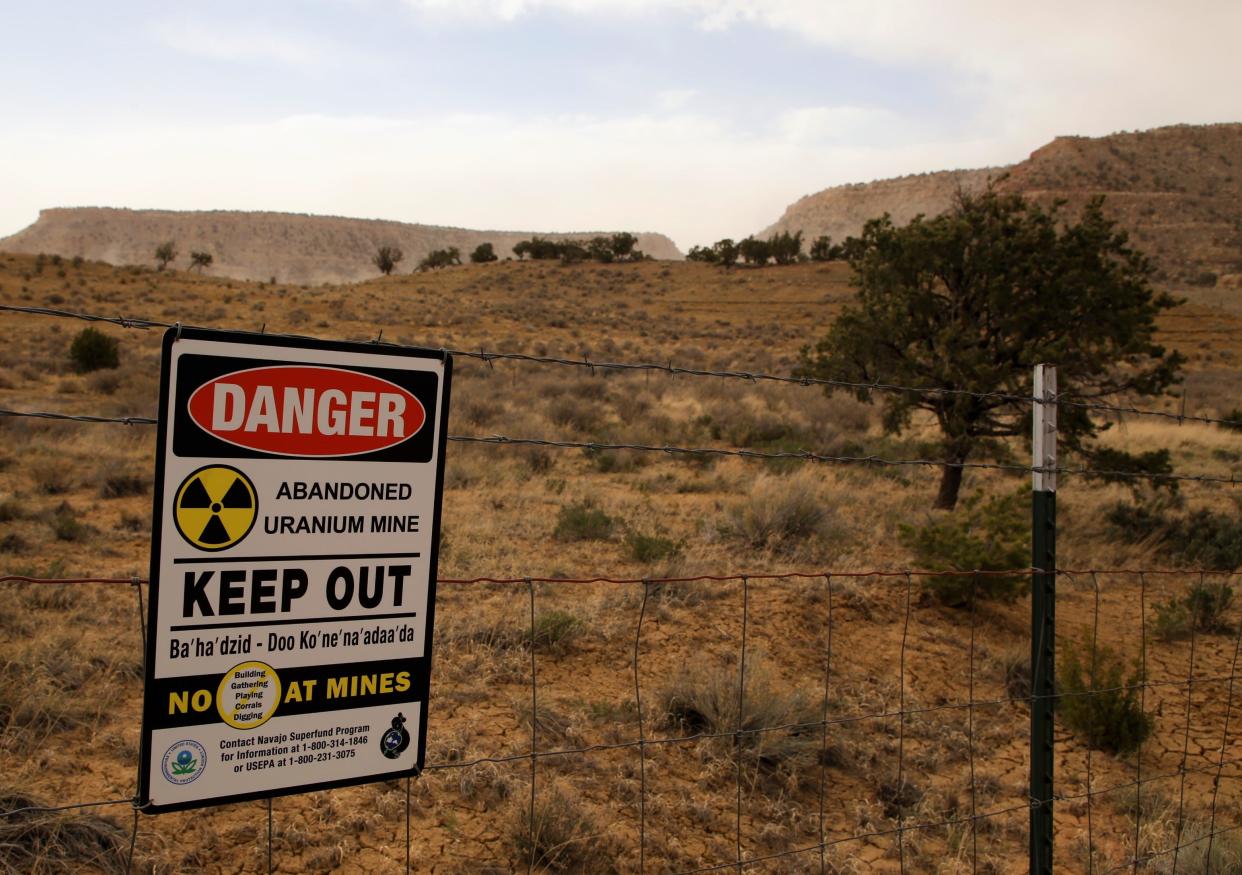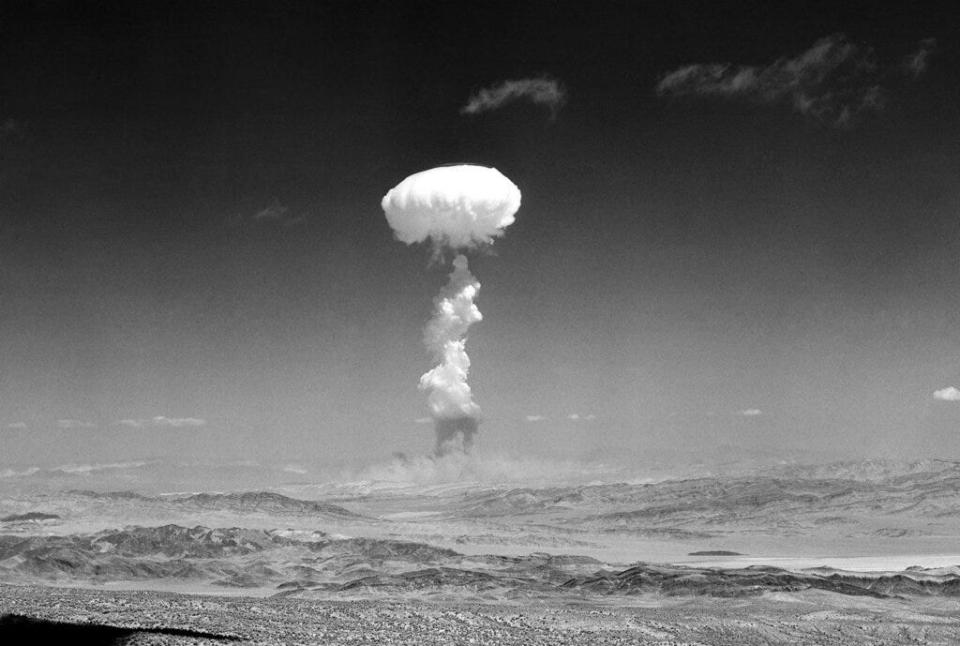Attorneys general back compensation efforts for people affected by nuclear weapons testing

- Oops!Something went wrong.Please try again later.
State prosecutors from across the U.S. are backing efforts to compensate people who were made sick by exposure to radiation from nuclear weapons testing.
In a letter to congressional leaders, state attorneys general from 13 states argue more people should be eligible for a compensation program available through a federal program as Congress considers passing a new bill.
"Downwinders" — people whose families suffered high rates of cancer attributed to U.S. nuclear weapons testing in the Nevada desert in the 1950s and '60s — could be eligible for more federal compensation under a proposed expansion to the Radiation Exposure Compensation Act.
The U.S. Senate earlier this year approved a major expansion to the program while passing a massive defense spending bill, proposing to extend health care coverage and compensation to downwinders and extending compensation to former uranium industry workers.
The bill advanced on a 86-11 vote in the Senate, although the RECA expansion is not yet included in a House-approved defense bill.
The hit summer film “Oppenheimer” about the top-secret Manhattan Project and the dawn of the nuclear age during World War II has brought new attention to the decades-long debate over compensation for families who were exposed to fallout and still grapple with related illnesses.
The issue hits close to home for New Mexico Attorney General Raúl Torrez, who penned the letter and explained that he spent his summers visiting his grandmother in southern New Mexico, who lived about 70 miles (110 kilometers) from where the Trinity Test was conducted. She used rainwater from her cistern for cooking and cleaning, unaware that it was likely contaminated as a result of the detonation.
The attorneys general who signed onto Torrez's letter are from Arizona, Colorado, Connecticut, Delaware, Maryland, Minnesota, Nevada, New York, Pennsylvania, Oregon, Rhode Island, Vermont and the District of Columbia.
The attorneys mentioned the work of a team of researchers who mapped radioactive fallout from nuclear weapons tests in the U.S., starting with the Trinity Test in 1945. The model shows the explosions carried out in New Mexico and Nevada between 1945 and 1962 led to widespread radioactive contamination, with Trinity making a significant contribution to exposure in New Mexico. Fallout reached 46 states as well as parts of Canada and Mexico.
“Without any warning or notification, this one test rained radioactive material across the homes, water, and food of thousands of New Mexicans,” the letter states. “Those communities experienced the same symptoms of heart disease, leukemia, and other cancers as the downwinders in Nevada.”
The letter also refers to an assessment by the federal Centers for Disease Control and Prevention, which acknowledged that exposure rates in public areas from the Trinity explosion were measured at levels 10,000 times higher than currently allowed.
U.S. Sen. Ben Ray Luján, the New Mexico Democrat who has been leading the effort to expand the compensation program to include New Mexico's downwinders and others in the West, held a listening session in Albuquerque last Thursday. Those exposed to radiation while working in uranium mines and mills spoke at the gathering about their experiences.

Luján in an interview called it a tough issue, citing the concerns about cost that some lawmakers have and the tears that are often shared by families who have had to grapple with cancer and other health problems as a result of exposure.
“It's important for everyone to learn these stories and embrace what happened,” he said, “so that we can all make things better.”
The Radiation Exposure Compensation Act was first passed in 1990 as an alternative to costly litigation to ensure the federal government met its financial responsibilities to workers who became sick as a result of the radiation hazards of their jobs. Coverage was broadened a decade later.
An estimated 60,000 people were exposed to radioactive fallout in southern Utah during the testing programs that took place at the Nevada Test Site, where nuclear weapons were tested and much of the radiation was sent "downwind" to the east via the prevailing winds.
For years, the federal government has issued money to those affected via the Radiation Exposure Compensation Act, which was set to expire last summer but was extended by for another two years.
Uranium mining on the Navajo Nation
Advocates also have been trying for years to bring awareness to the lingering effects of radiation exposure on the Navajo Nation, where millions of tons of uranium ore were extracted over decades to support U.S. nuclear activities.
“The Navajo Nation has borne the brunt of America’s nuclear program, the cost of which can be measured in human lives, environmental devastation, and communities that are still suffering," President Buu Nygren of the Navajo Nation said Thursday in a statement. "We will not stand by and allow this legacy to be forgotten or dismissed.”
The Senate bill would expand eligibility to more former uranium mining, processing and transportation workers who participated after 1971, the current cutoff date for eligibility.
History of the Radiation Exposure Compensation Act
Since the compensation program began in 1992, more than 54,000 claims have been filed and about $2.6 billion has been awarded for approved claims in Nevada, Utah and Arizona. Coverage would be expanded to New Mexico, Colorado, Idaho, Missouri, Montana and previously excluded areas of Nevada, Utah and Arizona.
Contributing: The Associated Press.
This article originally appeared on St. George Spectrum & Daily News: Attorneys general back downwinder compensation efforts

